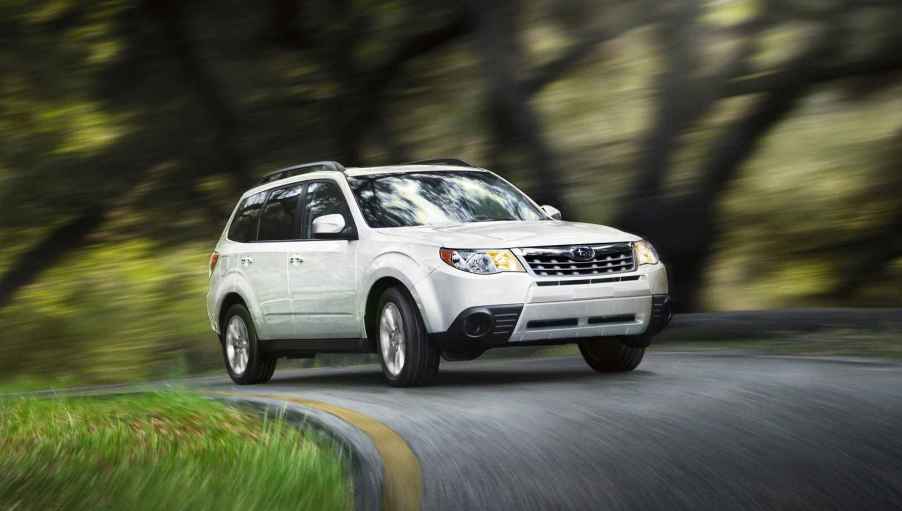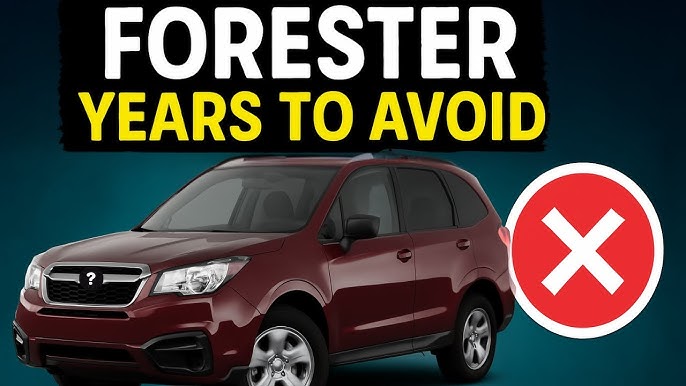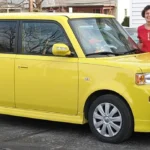When it comes to buying a car, especially a used one, you want to make a smart choice. The Subaru Forester is a popular pick, known for its reliability and performance.
But not all Foresters are created equal. Some model years have had their share of issues, and knowing which ones to avoid can save you time, money, and a lot of headaches. You might be wondering, “Which years should I steer clear of?
” Well, you’re in the right place. In this guide, we’ll uncover the specific Subaru Forester years to avoid, so you can make an informed decision and drive away with confidence. Keep reading, because the next few minutes could transform your car-buying experience.
Problematic Years And Their Challenges
The Subaru Forester is a beloved SUV known for its reliability and versatility. However, not all years are created equal. Some models have faced significant challenges, impacting their reputation and performance. Knowing which years had issues can save you from unexpected problems and costly repairs.
2009 Forester Concerns
In 2009, the Subaru Forester underwent a major redesign. While it promised improved space and comfort, it also brought some headaches. The most common problem? Engine failure. Many owners reported excessive oil consumption leading to engine issues. Imagine planning a road trip only to find your car guzzling oil faster than you can fill it. It’s a nightmare scenario.
Another challenge was the air conditioning system. Some drivers found themselves sweating through summer due to faulty AC units. If you live in a region with scorching summers, this could be a deal-breaker.
2011 Forester Drawbacks
The 2011 Forester had its share of troubles too. Transmission problems were the main concern. Owners often faced delayed shifting or jerking movements. Driving becomes a test of patience when your car doesn’t respond as expected.
Additionally, the electrical system was prone to glitches. You might find yourself fiddling with malfunctioning power windows or a temperamental stereo. It’s frustrating when simple comforts become unreliable.
2014 Forester Issues
The 2014 model introduced new technology but also new issues. A common complaint was the CVT (continuously variable transmission) system. Drivers reported a noticeable loss of acceleration power, making highway merging a stressful task.
Another challenge was the infotainment system. Many users found it unintuitive, often freezing or rebooting at inconvenient times. In today’s tech-driven world, a smooth interface is expected, not optional.
So, if you’re considering a used Forester, think about these years. Have you experienced similar issues with your car? Share your story and help others make informed decisions.

Credit: sinceremechanic.com
Engine And Transmission Troubles
When considering a Subaru Forester, potential buyers often rave about its rugged design and all-wheel-drive capability. However, some model years come with significant engine and transmission troubles that can lead to costly repairs and headaches. Understanding these issues can help you make an informed decision and possibly save you from future frustration.
Oil Consumption Problems
Many Subaru Forester owners have reported excessive oil consumption, particularly in models from the early 2010s. Imagine constantly checking your oil levels and making frequent trips to the store for oil refills. It’s not just a minor inconvenience; it can lead to severe engine damage if not addressed promptly.
This issue isn’t just a fluke. Numerous drivers have shared experiences of their oil light blinking on long road trips, making them feel anxious about possible engine failure. Does it make sense to purchase a vehicle that might need a quart of oil every thousand miles? Not really, especially when considering resale value and maintenance costs.
Transmission Failures
The Subaru Forester has also been plagued with transmission problems, notably the CVT (Continuously Variable Transmission) in some models. You might enjoy the smooth drive of a CVT, but what if it suddenly starts slipping or hesitating? That smooth drive quickly turns into a bumpy ride, both literally and financially.
Transmission failure is not just a nuisance; it’s an expensive repair that can burn a hole in your wallet. Owners have reported their vehicles jolting or losing power on the highway, which is not only frustrating but also dangerous. Would you feel comfortable driving a car that might leave you stranded?
While the Forester offers some fantastic features, being aware of these engine and transmission issues can save you from unwanted surprises. Have you checked if the model year you’re considering is known for these problems? Taking the time to research could be your best move.
Electrical And Technological Faults
Subaru Forester is a beloved SUV, but not all years are created equal. If you’re considering buying a used Forester, watch out for certain years plagued by electrical and technological faults. These issues can turn your dream car into a headache. Knowing what to expect can save you from expensive repairs and frustrating experiences.
Infotainment System Glitches
Imagine driving your Subaru Forester, ready to enjoy your favorite playlist, only to find your infotainment system frozen. It’s a common issue in some Forester models. You might experience frequent screen freezes or unresponsive buttons. This can make simple tasks like changing radio stations a chore.
These glitches can affect your driving experience, turning long drives into a test of patience. While some owners have found success with software updates, others have had to replace entire units. It’s worth considering if you value seamless tech in your car.
Battery And Alternator Problems
Another common issue is battery and alternator problems. You might find yourself unable to start your Forester on a chilly morning or face unexpected battery drains. These issues are more than just inconvenient—they can leave you stranded when you least expect it.
Owners have reported frequent battery replacements or alternator fixes. Some have had success with aftermarket solutions, but it’s a hassle you’d rather avoid. Are you prepared for these potential pitfalls, or would you rather opt for a more reliable year?
By understanding these electrical and technological faults, you can make a more informed decision. Whether you’re buying your first Forester or upgrading, knowing what to look for can help you avoid these common issues. Stay informed and drive with confidence!

Credit: www.motorbiscuit.com
Safety And Structural Concerns
Subaru Forester has been a popular choice for many drivers. Yet, some model years face safety and structural concerns. These issues have affected the vehicle’s reliability and reputation. Understanding these problems can help potential buyers make informed decisions.
Airbag Recalls
Some Subaru Forester models have had airbag recall issues. Defective airbags can pose serious risks to drivers and passengers. These airbags might not deploy correctly during collisions. This malfunction increases the chance of injury or worse. Always check if the Forester model you’re interested in has been part of such recalls.
Rust And Corrosion Issues
Rust and corrosion have troubled certain Forester years. These issues often stem from poor-quality materials used in manufacturing. Rust can weaken the car’s structure over time. This leads to safety hazards, especially during accidents. Regular inspections can help detect early signs of rust. Addressing these issues promptly can prevent further damage.
Cost Implications For Repairs
Owning a Subaru Forester offers many benefits, but repair costs can add up. Certain model years are more prone to issues, increasing repair expenses. Understanding these costs helps in budgeting and maintaining your Forester effectively.
Repair Costs For Common Problems
Some Subaru Forester models face frequent head gasket failures. Repairing a head gasket can cost between $1,500 and $2,000. Transmission issues are also common in certain years. Fixing a faulty transmission may cost over $3,000. Electrical problems can arise, leading to unexpected expenses. Simple electrical repairs might cost a few hundred dollars, but complex issues could run into thousands.
Long-term Maintenance Expenses
Regular maintenance keeps your Subaru Forester running smoothly. Oil changes, tire rotations, and brake checks are essential. These services may cost around $300 annually. Timing belt replacements are vital, occurring every 100,000 miles. Replacing a timing belt costs approximately $800. Ignoring regular maintenance increases long-term repair costs significantly. Addressing small issues early prevents expensive repairs later on.
Tips For Buying A Used Forester
Certain Subaru Forester models may have more issues than others. Research shows 2009 and 2014 models often face engine problems. Buying a used Forester? Consider avoiding these years for a smoother experience.
Buying a used Subaru Forester can be a smart move, but it requires some careful consideration to ensure you get a good deal. These vehicles are known for their reliability, but like any used car, they can have hidden issues. Knowing what to look for and how to negotiate can make the difference between a great purchase and a costly mistake. Dive into these practical tips to help you navigate the process like a pro.Inspection Checklist
When checking out a used Forester, the first step is a thorough inspection. Start with the exterior. Look for signs of rust, dents, and mismatched paint, which could indicate past accidents. Under the hood, check the engine and look for oil leaks or corrosion. The engine bay should be clean, but not overly so—this could be a sign of recent masking of issues. Don’t forget the interior. Check for wear on the seats and controls. Test all electronics, including lights, windows, and the air conditioning. Take a moment to sniff for any moldy or smoky smells which can be difficult to remove. Take a test drive. Listen for unusual noises and pay attention to how the vehicle handles. Does it brake smoothly? Does it pull to one side? These could be warning signs of bigger issues.Negotiating Price Based On Condition
Once you’ve completed your inspection, it’s time to talk money. Be ready to negotiate based on what you’ve discovered. If there are minor issues, use them to your advantage to lower the price. Research the market value of the model year you’re interested in. Websites like Kelley Blue Book can provide a fair value estimate. This knowledge can be your best ally in negotiations. Don’t be shy about walking away if the seller isn’t flexible. There are always other Foresters out there. Remember, patience can save you a lot of money. Think about how long you plan to keep the car. If you need it to last several years, it may be worth investing a bit more upfront for a vehicle in better condition. Buying a used Forester doesn’t have to be daunting. With these steps, you’re more likely to end up with a reliable car that fits your budget. What are your personal tips when buying a used car? Share in the comments below!
Credit: www.copilotsearch.com
Conclusion
Choosing a Subaru Forester requires careful thought. Certain years faced reliability issues. Knowing which years to avoid helps make a smart choice. Research and reviews guide you to better options. Find models with strong records. They offer peace of mind and better performance.
Investing time in research pays off. Your decision affects long-term satisfaction. A reliable Forester enhances driving experiences. Stay informed and choose wisely. Consider maintenance history before buying. Protect your investment and enjoy the ride. Quality matters for a dependable vehicle.
Make informed choices to avoid future regrets.



